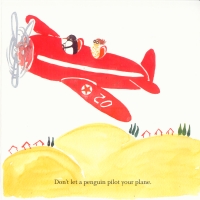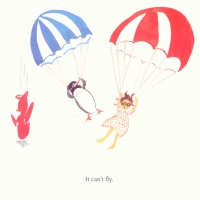| ________________
CM . . .
. Volume XXI Number 14 . . . . December 5, 2014

 |
Donít.
Litsa Trochatos. Illustrated by Virginia Johnson.
Toronto, ON: Groundwood Books/House of Anansi Press, 2014.
24 pp., board book & pdf, $9.95 (board).
ISBN 978-1-55498-355-1 (board), ISBN 978-1-55498-356-8 (pdf).
Subject Heading:
Animals-Juvenile fiction.
Preschool / Birth-age 3.
Review by Barb Janicek.
** /4
|

excerpt:
Donít let a cheetah drive your car. It likes to go really, really fast.
Donít play badminton with a frog. It might mistake the birdie for a fly.
Donít let a penguin pilot your plane. It canít fly.
Donít play fetch with a turtle. It will take a very long time to bring back the ball.
Donít is a clever book, with beautiful illustrations, which may be a victim of poor format choice. Published as a board book, the indication or expectation of that format is that it is a book for babies and toddlers. In fact, the accompanying insert from the publisher indicates that the audience is Ages 0 to 3 with a description of ďan entertaining board book for the very youngest animal lovers.Ē The complexity of the punny jokes, however, is well above that developmental age, which makes reviewing it a difficult task. As a book for grades 2-3, it is okay. As a board book for babies? Not even close.
 Simple does not mean easy. The text follows a simple pattern of doníts: why you would not want to do certain things with certain animals. But the punchline for each one puts the book more at an early to middle grade level. Kids do not begin to develop a sense of humour for jokes or puns until that time. This book is not funny (whether or not it is intended to be), and it is clearly not attempting to be a joke book, but the vocabulary and language that it relies on is the same as puns. You have to understand that a turtle is slow to get why it would take forever to bring back a ball. In the early years, especially ages 0 to 3, that information is new. Books for babies should be clearly and explicitly stating that a turtle is slow. Simple does not mean easy. The text follows a simple pattern of doníts: why you would not want to do certain things with certain animals. But the punchline for each one puts the book more at an early to middle grade level. Kids do not begin to develop a sense of humour for jokes or puns until that time. This book is not funny (whether or not it is intended to be), and it is clearly not attempting to be a joke book, but the vocabulary and language that it relies on is the same as puns. You have to understand that a turtle is slow to get why it would take forever to bring back a ball. In the early years, especially ages 0 to 3, that information is new. Books for babies should be clearly and explicitly stating that a turtle is slow.
 The illustrations offer a similar dilemma. In early childhood education, it is understood that photos are more effective than illustrations or stylized drawing (art) because the objects are recognizable. Virginia Johnsonís watercolours, by the nature of their artistry, are not detailed or clear enough for the bookís intended age range. There is too much happening in each picture while, at the same time, there is not nearly enough detail in faces, bodies, or backgrounds. They are beautiful illustrations for children ages 4 and up, perhaps, but less effective for infants who canít yet focus on pages and need single images on each page or contrast in colours. The illustrations offer a similar dilemma. In early childhood education, it is understood that photos are more effective than illustrations or stylized drawing (art) because the objects are recognizable. Virginia Johnsonís watercolours, by the nature of their artistry, are not detailed or clear enough for the bookís intended age range. There is too much happening in each picture while, at the same time, there is not nearly enough detail in faces, bodies, or backgrounds. They are beautiful illustrations for children ages 4 and up, perhaps, but less effective for infants who canít yet focus on pages and need single images on each page or contrast in colours.
While Donít might have found a limited audience of children who like cute-and-cheesy stories and animals, if published as a picture book, it really misses the mark as a board book for babies and toddlers.
Recommended with Reservations.
Barb Janicek is a Childrenís Librarian with Kitchener Public Library, in Kitchener, ON.

To comment on this title or this review, send mail to cm@umanitoba.ca.
Copyright © the Manitoba Library Association. Reproduction for personal use is permitted only if this copyright notice is maintained. Any
other reproduction is prohibited without permission.
CM Home |
Next Review |
Table of Contents for This Issue - December 5, 2014
| Back Issues | Search | CM Archive
| Profiles Archive
|

 Simple does not mean easy. The text follows a simple pattern of doníts: why you would not want to do certain things with certain animals. But the punchline for each one puts the book more at an early to middle grade level. Kids do not begin to develop a sense of humour for jokes or puns until that time. This book is not funny (whether or not it is intended to be), and it is clearly not attempting to be a joke book, but the vocabulary and language that it relies on is the same as puns. You have to understand that a turtle is slow to get why it would take forever to bring back a ball. In the early years, especially ages 0 to 3, that information is new. Books for babies should be clearly and explicitly stating that a turtle is slow.
Simple does not mean easy. The text follows a simple pattern of doníts: why you would not want to do certain things with certain animals. But the punchline for each one puts the book more at an early to middle grade level. Kids do not begin to develop a sense of humour for jokes or puns until that time. This book is not funny (whether or not it is intended to be), and it is clearly not attempting to be a joke book, but the vocabulary and language that it relies on is the same as puns. You have to understand that a turtle is slow to get why it would take forever to bring back a ball. In the early years, especially ages 0 to 3, that information is new. Books for babies should be clearly and explicitly stating that a turtle is slow.  The illustrations offer a similar dilemma. In early childhood education, it is understood that photos are more effective than illustrations or stylized drawing (art) because the objects are recognizable. Virginia Johnsonís watercolours, by the nature of their artistry, are not detailed or clear enough for the bookís intended age range. There is too much happening in each picture while, at the same time, there is not nearly enough detail in faces, bodies, or backgrounds. They are beautiful illustrations for children ages 4 and up, perhaps, but less effective for infants who canít yet focus on pages and need single images on each page or contrast in colours.
The illustrations offer a similar dilemma. In early childhood education, it is understood that photos are more effective than illustrations or stylized drawing (art) because the objects are recognizable. Virginia Johnsonís watercolours, by the nature of their artistry, are not detailed or clear enough for the bookís intended age range. There is too much happening in each picture while, at the same time, there is not nearly enough detail in faces, bodies, or backgrounds. They are beautiful illustrations for children ages 4 and up, perhaps, but less effective for infants who canít yet focus on pages and need single images on each page or contrast in colours.